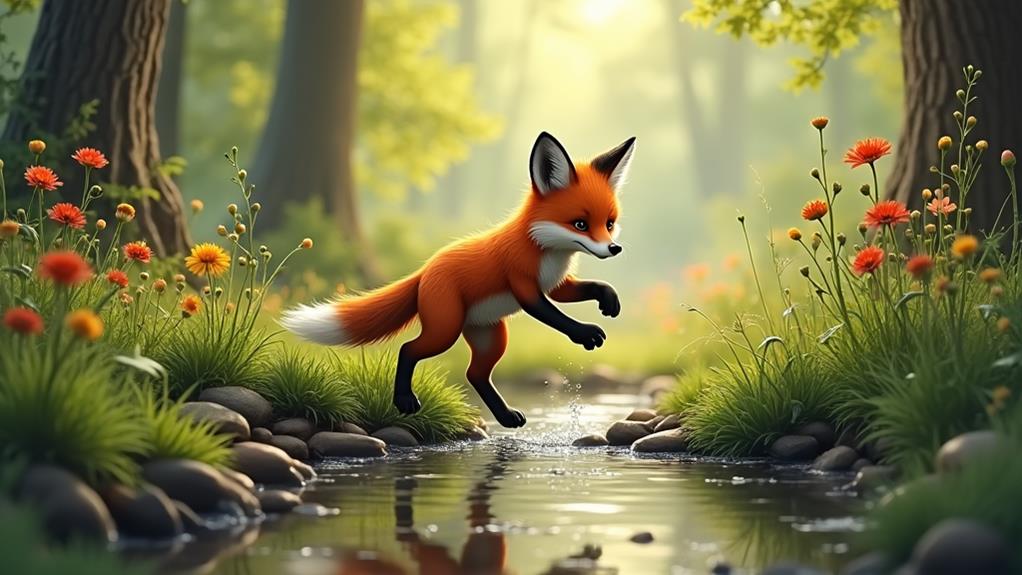Baby red foxes, or kits, are mostly safe and super curious little creatures. They love to explore and play, but it's best to admire them from a distance to keep things comfy for both you and them. While these playful pups aren't usually dangerous, mama foxes can get protective if they feel threatened. Just think of them as the cute neighborhood kids who love to frolic but might have a fierce mom watching over them! So, keep your pets close, and you'll be all set. Want to know more about how to enjoy their antics safely? There's plenty more to uncover!
Contents
Fox Cubs and Human Safety
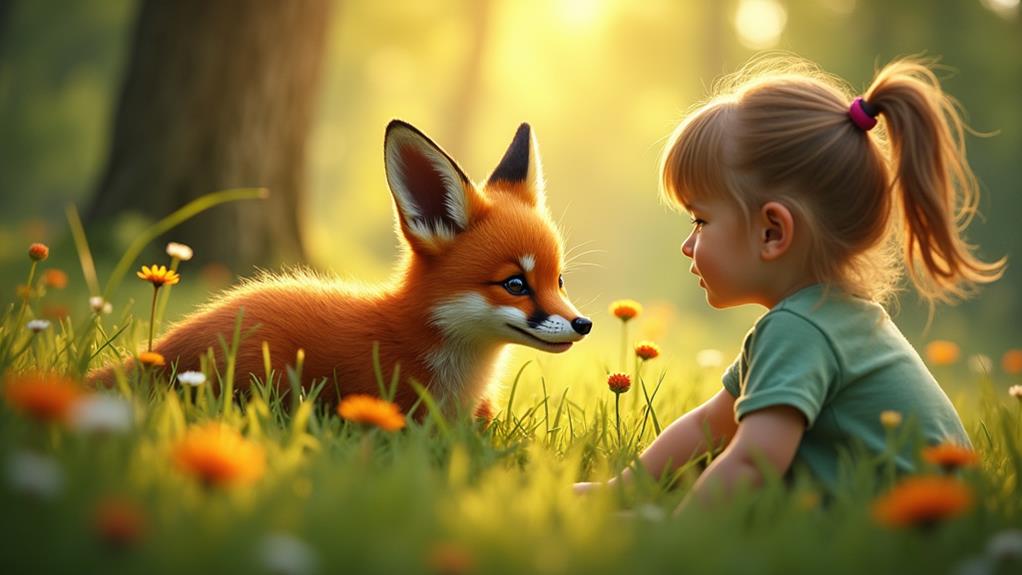
When you spot a baby red fox, or kit, it's hard not to be charmed by their playful antics. These little bundles of fur, born blind and deaf, depend entirely on their mothers for care.
Red foxes exhibit remarkable adaptability, allowing them to thrive in diverse environments, which guarantees that their young have plenty of safe spaces to grow and explore habitats and distribution of red foxes.
So, you might wonder, are foxes dangerous? Generally, no! Kits aren't aggressive; they're just curious and playful. However, it's wise to remember that if they feel threatened, they could react defensively.
If you happen to find kits outside their fox den, don't rush to assume something's wrong. Mother foxes often watch from a distance, assuring their little ones are safe.
It's best to observe them from afar to keep stress at bay—for both you and the kits. Approaching or handling these adorable babies could make them feel cornered or frightened, and that's the last thing you'd want to do!
Engaging with wildlife responsibly allows us to appreciate these beautiful creatures without putting them in jeopardy.
Understanding Fox Behavior
As they reach around six weeks old, these curious little furballs start exploring outside their dens.
With urban habitats providing ample food availability, this can lead to more sightings, but urban foxes often act bolder. Remember, this doesn't mean they're dangerous; they're just naturally curious about the world around them.
Understanding fox behavior is key. Foxes prefer to avoid confrontation and tend to seek safety in numbers.
So, if you spot a kit, it's usually just looking for a new adventure, not causing trouble. Knowledge is power! By learning about these playful creatures, you can help ease fears about their presence in your neighborhood.
Risks to Domestic Pets
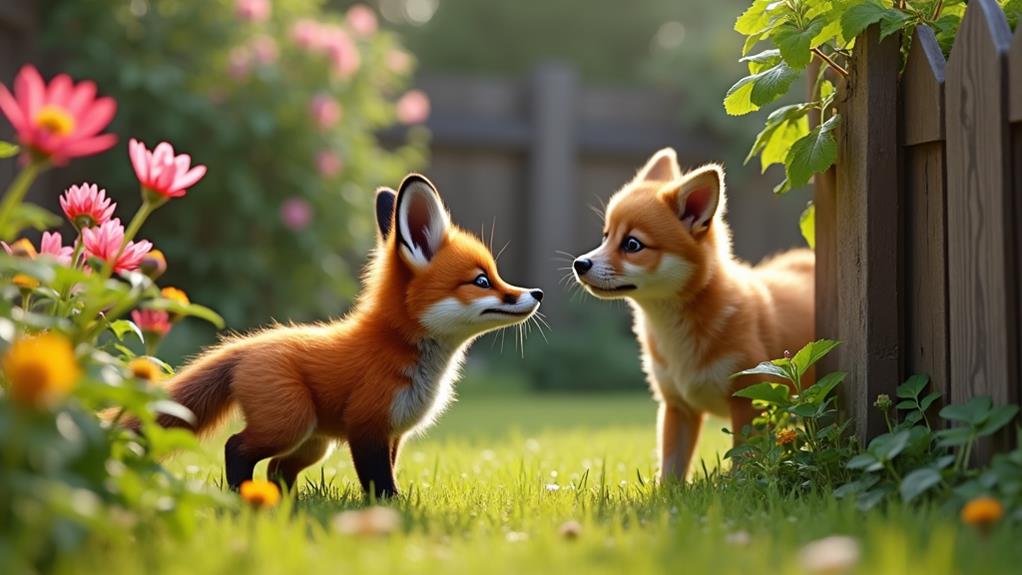
While understanding fox behavior helps alleviate worries about their presence, it's still important to contemplate the potential risks they pose to domestic pets. Most cats are generally safe from foxes, but if you have small pets like rabbits or kittens, you'll want to keep an eye on them.
Red foxes are often found in various habitats where they can display curious behavior, and these curious little creatures might see smaller animals as potential snacks!
Studies show that only 0.14% of cats in the UK have been attacked by foxes, which is reassuring. Attacks on small dogs are also quite rare—usually involving small breeds left unattended outdoors.
Still, it's wise to be cautious. Protective mother foxes can get aggressive if they think their cubs are threatened, especially if they feel cornered.
Signs of Illness in Foxes
Understanding the signs of illness in foxes is essential for anyone observing these wild animals in urban or rural settings. If you notice a fox acting unusually tame or aggressively, it might be a sign of rabies. Sick foxes can appear weak or lethargic, making them more vulnerable to predators and less able to hunt.
Their appearance might also change, with severe hair loss and itchiness due to mange—those pesky Sarcoptes scabiei mites are to blame!
Look out for symptoms like staggering or difficulty moving, which can indicate serious health issues. While you want to help, remember that sick foxes may react defensively if they feel threatened. So, keep your distance!
It's a good idea to educate yourself about how sick foxes could affect your pets, especially if you have adventurous cats that might try to attack them!
Understanding these signs not only helps you stay safe but also helps protect these fascinating creatures from potential harm. By remaining vigilant and informed, you're playing a part in the well-being of foxes and our environment, which is always a win-win!
Managing Fox Encounters
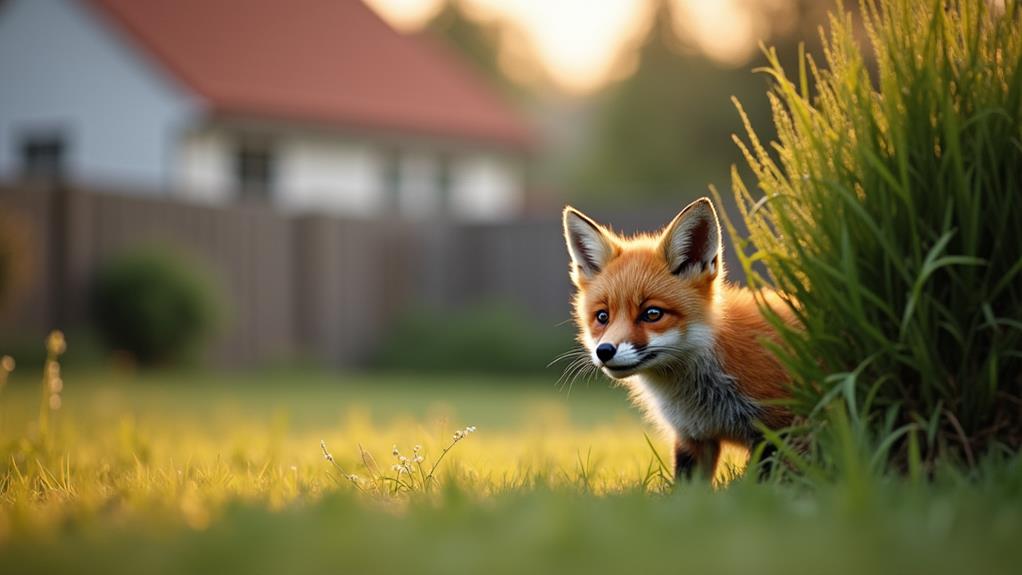
Managing encounters with foxes requires a proactive approach, keeping both you and the animals safe.
While foxes are often viewed with caution, it's good to know that with a little awareness and preparation, you can easily manage these interactions.
Here are some practical tips:
- Maintain a safe distance from fox dens to avoid provoking defensive behaviors from mothers.
- Keep an eye out for unusual behavior which could indicate illness.
- Use loud noises, water, or shiny objects to deter bold foxes from your space.
- Secure trash and pet food to minimize attractions around your home.
Fox Den Dynamics
When you think about fox dens, picture cozy little hideaways tucked under porches or in overgrown corners of your yard, offering shelter for cute cubs.
But don't be fooled by their adorable appearance—vixens can turn fierce if they feel threatened, especially when their young ones are at stake.
Den Location and Safety
Fox dens are often cleverly concealed under structures like porches or sheds, offering safety and shelter for raising young cubs. If you find yourself near a fox den, it's important to respect the space of the fox family. Disturbing their home can lead to a defensive reaction from the mother, which isn't ideal for anyone involved.
Here are a few things to keep in mind:
- Fox dens provide shelter and safety for cubs.
- Kits usually leave the den at around 4-5 weeks old.
- A den near your home means the foxes are comfortable in your area.
- Maintain a safe distance to avoid stressing the animals.
It's fascinating to watch the fox family grow, but remember to give them the space they need. As the kits come out to explore, encounters with humans can increase.
If you notice the mother's behavior changing or signs of abandonment, it's best to leave it to nature. By being mindful and allowing these precious creatures their space, you can enjoy watching them grow up safely, without causing them any unnecessary stress!
Protective Behavior of Vixens
Vixens display remarkable protective behavior, especially when their vulnerable kits are around. They're fiercely dedicated mothers, and when those cute little furballs are just a few weeks old, you better believe a vixen will become a mini bodyguard. If she senses any potential threat, she won't hesitate to show her aggressive side!
These clever creatures often choose cozy, secluded spots for their dens, like under your porch or in thick bushes, ensuring their young stay safe and sound. Vixens typically nurse their litters of 4 to 5 kits for about 4 to 5 weeks before letting them explore the world—talk about being a helicopter parent!
When someone disturbs her den, it can lead to anxiety for the vixen, prompting her to move her kits too soon. This could expose them to dangers they aren't ready to face.
Additionally, vixens are territorial critters. They mark their area, keeping intruders at bay and protecting their precious offspring. It's like they're saying, "Not on my watch!"
Common Denning Areas
Nestled in secluded spots like under porches or thick shrubs, red fox dens provide a safe haven for vulnerable kits. These clever local animals showcase their adaptability by either digging their own dens or repurposing existing burrows. You might be surprised to spot them!
Here are some common denning areas where you could find these playful critters:
- Under decks or porches, hiding from prying eyes
- In dense brush or tall grass, camouflaging in plain sight
- Abandoned burrows from other animals, keeping it cozy
- Near compost bins or garbage, drawn by food sources
Dens serve as a cozy space for kits until they're about four to five weeks old, when they start exploring the world outside.
It's common to see them returning to the same dens year after year, showcasing their territorial nature. If you notice a den nearby, remember this might increase interactions with humans, especially if food scraps play a role.
Just like we cherish our homes, these furry friends value their dens. Enjoy watching them, but keep a respectful distance, and let their playful antics brighten your day!
Safe Observation Practices
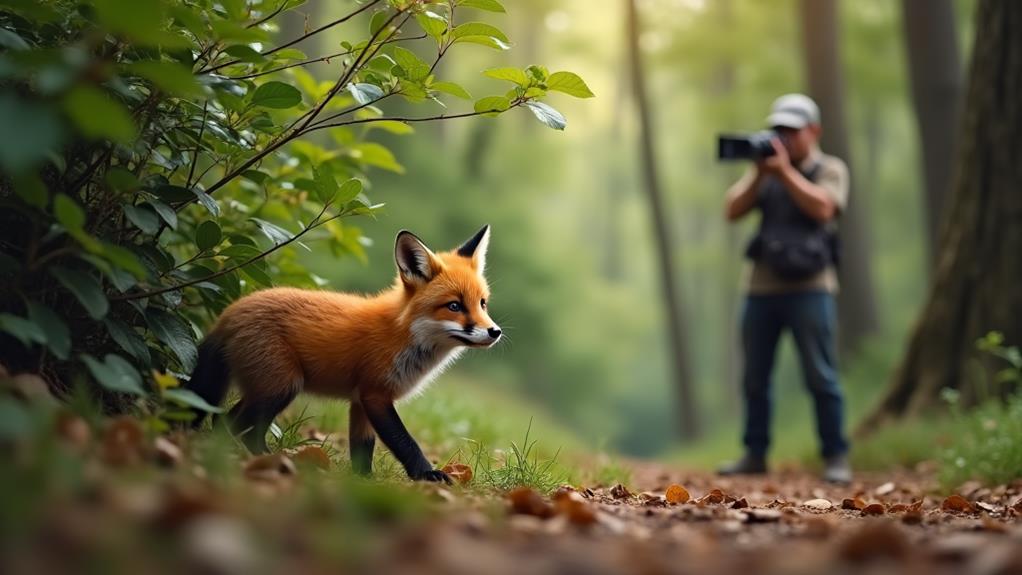
When observing baby red foxes, it's important to prioritize their safety and well-being. Keeping a safe distance is vital; if you get too close, you might provoke a protective mother. Trust me, she's not in the mood for intruders when she's busy looking for food for her little ones!
By watching these adorable creatures from afar, you'll get to appreciate their natural behavior without causing them any stress or disruption.
If you spot a baby fox alone, resist the urge to intervene right away. Give it one to two hours because the mother is likely nearby and may return to care for her cubs.
Disease Awareness and Prevention
Baby red foxes can be incredibly cute, but it's important to be aware of the potential health risks they may pose. These adorable little creatures can carry diseases like rabies. Although transmission to humans is rare, staying informed can keep everyone safe.
Here are a few key points to remember for disease awareness and prevention:
- Look for signs of rabies in foxes, like aggression and unusual tameness.
- Always keep your distance from wild baby foxes and their dens.
- Vaccinate your pets regularly, especially if you live near fox habitats.
- If you spot a sick or injured baby fox, don't try to handle it.
Instead, contact wildlife services or local animal control for the right help.
Remember, if you notice any unusual behavior, it's crucial to act quickly and get medical attention—both for the fox and yourself.
Wildlife Protection Efforts
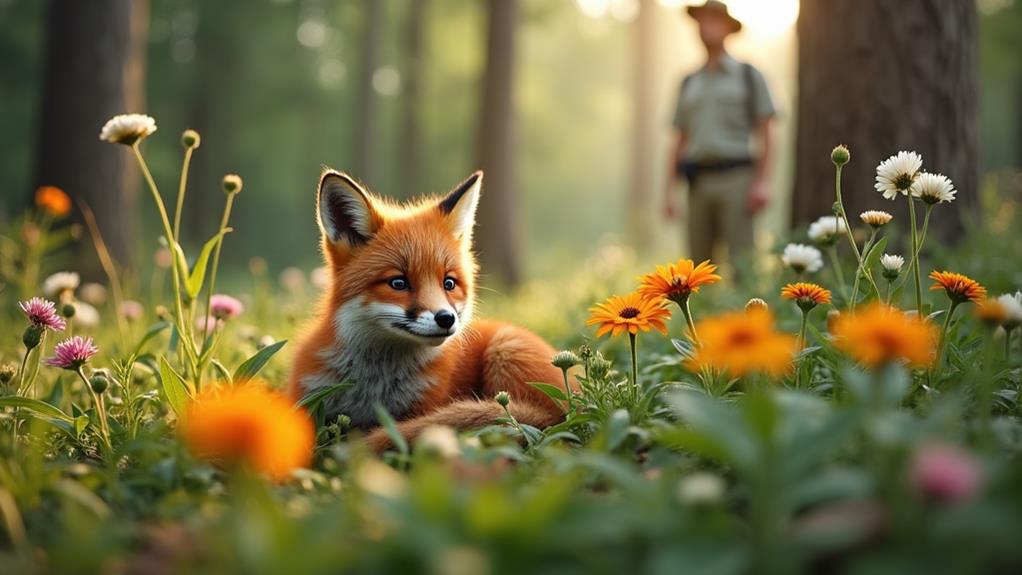
When it comes to protecting baby red foxes, habitat conservation is key.
You mightn't realize it, but your support can go a long way in creating a safe home for these adorable creatures.
Habitat Conservation Strategies
The conservation of red fox habitats is essential for ensuring their survival and maintaining ecological balance. Many strategies can help protect these clever little creatures and their homes. Here are some effective habitat conservation strategies you can support:
- Restore native vegetation: Plant local species to provide food and shelter for red foxes.
- Reduce urban sprawl: Advocate for responsible development that leaves natural areas intact.
- Protect wildlife corridors: Work with local governments to enforce zoning laws that keep these significant travel routes safe.
- Support wildlife reserves: Establish protected areas for red foxes to thrive undisturbed.
By engaging in these efforts, you're not just helping red foxes; you're promoting biodiversity and healthier ecosystems overall.
Remember, red foxes play an essential role in controlling rodent populations, so keeping their habitat in check benefits everyone.
Plus, you'll be creating a more enjoyable environment for people and wildlife alike.
Public education campaigns can also be a great way to spread the word about conservation.
The more folks understand how to coexist sustainably with urban wildlife, including those adorable baby red foxes, the better.
Together, we can make a paws-itive difference!
Community Involvement Initiatives
Engaging your community in wildlife protection efforts is essential for preserving local ecosystems and supporting the charming red fox population. When you become involved, it's like adding a splash of color to a bland painting; your participation truly makes a difference! Educating your neighbors about why we need to protect wildlife can spark important conversations about biodiversity.
Consider organizing a community event to raise funds for creating humane backyards. These spaces not only support the red foxes but also improve your neighborhood's harmony with nature.
Working with local schools can inspire kids to care for these creatures, teaching them about the importance of wildlife protection from an early age. They might even turn into little fox advocates!
Moreover, volunteer programs allow you to join like-minded folks in monitoring wildlife populations. Together, you can take steps to mitigate habitat loss and food scarcity for these playful foxes.
Collaborating with wildlife organizations brings out the superhero in all of us, creating impactful community-led initiatives. So, roll up your sleeves and immerse yourself—every little bit of community involvement helps keep our adorable red foxes safe!
Expert Assistance and Resources
How can you navigate encounters with baby red foxes safely? When you come across these adorable little creatures, it's important to know who to reach out to for expert assistance. Baby red foxes may seem harmless, but understanding the right steps can guarantee the safety of both you and the foxes.
Consider these options if you find yourself in a situation with a baby fox:
- Contact local wildlife rehabilitators for guidance if a fox seems abandoned.
- Reach out to wildlife services for education on fox behavior and coexistence.
- Familiarize yourself with local regulations, so you know what's legally acceptable.
- Use community hotlines to report any sightings or concerns for proper assistance.
These resources help keep both you and the wildlife safe. By working with experienced professionals, you can guarantee that baby red foxes get the help they need.
Final Thoughts
In the end, baby red foxes are more curious than dangerous. While it's tempting to get up close, remember: they're wild animals with instincts you'll want to respect. Keep an eye on your pets, and if you see a fox, enjoy the moment from a safe distance. After all, who wouldn't want to witness nature's little comedians at play? With a little caution and common sense, you can appreciate these adorable creatures without any worry!

